Hashishiin
Gold Member
- Joined
- Dec 29, 2021
- Messages
- 4,184
Hello, this is a two part question. The first is simpler, second is the first step in what may be a multi step process.
So, I need my Spyderco Cricket, favored work knife. Somewhere along the way, the very very end of the tip was lost, likely hitting glass cutting open bags of recycling. It can still peirce, but I would like the full tip back.
I hope the following pictures show the issue well. I notice that last, not serrated point part, straight like a pointy Wharncliffe. I have a sharpmaker with CBN and brown/white rods, a file, strop, and a 500 grit stone. I do not want to screw it up. This is why I want advice, sharpening it did not help but much, I thought about running it down the spine, taking it down? How would ya do it? It is not a knife ending issue but I'd like to correct it.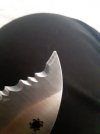
_______
I have aquired an AUS-8 Espada, with the original deeper hollow grind, and deeper clip than the XHP models. Love it. It has great action. It has an edge. It.. is missing a bolster, may have been stonewashed at the bolsters, and cannot unscrew the right scale because it is as though it got blown out and concrete-d back in. There is a hard, scratchy, concrete like substance in there. I don't know man, I got it for a quick 99 bucks in a lot deal, including gems like my first Ozark Trail, a Dollica and a combat... tomahawk thing.
I wonder if I can save this, or whether I need to get a modern one and switch blades, if this even fits still. But, I'd like to try to salvage it, and the concrete stuff prevents unscrewing. Any idea what it is, or do I just have to try to knock it out?
Then, I gotta make a bolster.
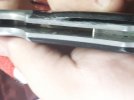
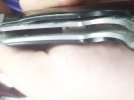
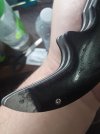
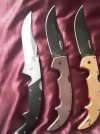
So, I need my Spyderco Cricket, favored work knife. Somewhere along the way, the very very end of the tip was lost, likely hitting glass cutting open bags of recycling. It can still peirce, but I would like the full tip back.
I hope the following pictures show the issue well. I notice that last, not serrated point part, straight like a pointy Wharncliffe. I have a sharpmaker with CBN and brown/white rods, a file, strop, and a 500 grit stone. I do not want to screw it up. This is why I want advice, sharpening it did not help but much, I thought about running it down the spine, taking it down? How would ya do it? It is not a knife ending issue but I'd like to correct it.

_______
I have aquired an AUS-8 Espada, with the original deeper hollow grind, and deeper clip than the XHP models. Love it. It has great action. It has an edge. It.. is missing a bolster, may have been stonewashed at the bolsters, and cannot unscrew the right scale because it is as though it got blown out and concrete-d back in. There is a hard, scratchy, concrete like substance in there. I don't know man, I got it for a quick 99 bucks in a lot deal, including gems like my first Ozark Trail, a Dollica and a combat... tomahawk thing.
I wonder if I can save this, or whether I need to get a modern one and switch blades, if this even fits still. But, I'd like to try to salvage it, and the concrete stuff prevents unscrewing. Any idea what it is, or do I just have to try to knock it out?
Then, I gotta make a bolster.




